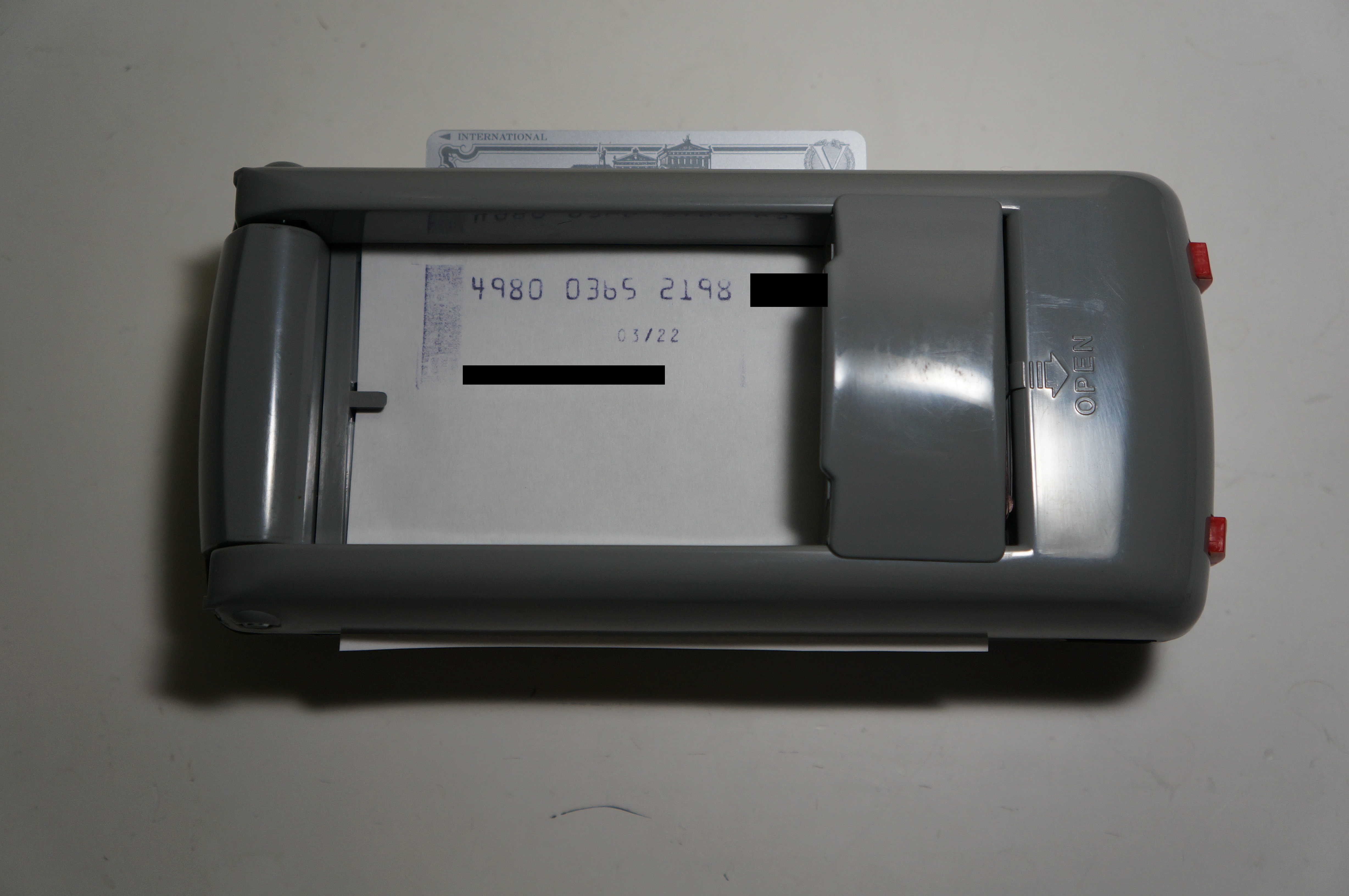credit card imprinter on:
[Wikipedia]
[Google]
[Amazon]

 A credit card imprinter, colloquially known as a ZipZap machine, click-clack machine or Knuckle Buster, is a manual device that was used by merchants to record
A credit card imprinter, colloquially known as a ZipZap machine, click-clack machine or Knuckle Buster, is a manual device that was used by merchants to record
 These devices were used from the advent of
These devices were used from the advent of
 A credit card imprinter, colloquially known as a ZipZap machine, click-clack machine or Knuckle Buster, is a manual device that was used by merchants to record
A credit card imprinter, colloquially known as a ZipZap machine, click-clack machine or Knuckle Buster, is a manual device that was used by merchants to record payment card
Payment cards are part of a payment system issued by financial institutions, such as a bank, to a customer that enables its owner (the cardholder) to access the funds in the customer's designated bank accounts, or through a credit account and ...
transactions before the advent of payment terminal
A payment terminal, also known as a point of sale (POS) terminal, credit card machine, card reader, PIN pad, EFTPOS terminal (or by the older term as PDQ terminal which stands for "Process Data Quickly"), is a device which interfaces with payme ...
s.
The device works by placing the customer’s credit card into a bed in the machine, then layering carbon paper
Carbon paper (originally carbonic paper) consists of sheets of paper that create one or more copies simultaneously with the creation of an original document when inscribed by a typewriter or ballpoint pen. The email term cc which means "carbon ...
forms over the card. A bar is slid back and forth over the paper to create an impression of the embossed card data and the merchant information on the imprinter. The customer signs these paper forms, with one copy as the customer receipt and the other kept by the merchant.
History
 These devices were used from the advent of
These devices were used from the advent of charge card
A charge card is a type of credit card that enables the cardholder to make purchases which are paid for by the card issuer, to whom the cardholder becomes indebted. The cardholder is obliged to repay the debt to the card issuer in full by the d ...
s and payment card
Payment cards are part of a payment system issued by financial institutions, such as a bank, to a customer that enables its owner (the cardholder) to access the funds in the customer's designated bank accounts, or through a credit account and ...
s in the 1950s60s until the 1980s90s when electronic payment terminals started to replace them. They continued to be used well into the 2000s for places where network access was difficult, such as mobile locations like taxis and airplanes, or as a backup system in case of payment terminal failure. This practice has been abandoned as of the 2020s, with payment terminal failure now typically resulting in businesses accepting cash
In economics, cash is money in the physical form of currency, such as banknotes and coins.
In book-keeping and financial accounting, cash is current assets comprising currency or currency equivalents that can be accessed immediately or near-i ...
only or refusing to process transactions until the system is restored.
Starting in the late 2010s, some credit card issuers began to use cards without embossed numbers, making them incompatible with card imprinters.
See also
*EFTPOS
Electronic funds transfer at point of sale, abbreviated as EFTPOS (), is a type of payment transaction in which electronic funds transfers (EFT) are processed at a point of sale (POS) system or payment terminal usually via payment methods such as ...
* Payment terminal
A payment terminal, also known as a point of sale (POS) terminal, credit card machine, card reader, PIN pad, EFTPOS terminal (or by the older term as PDQ terminal which stands for "Process Data Quickly"), is a device which interfaces with payme ...
References
{{Credit cards Merchant services Credit card terminology Banking technology